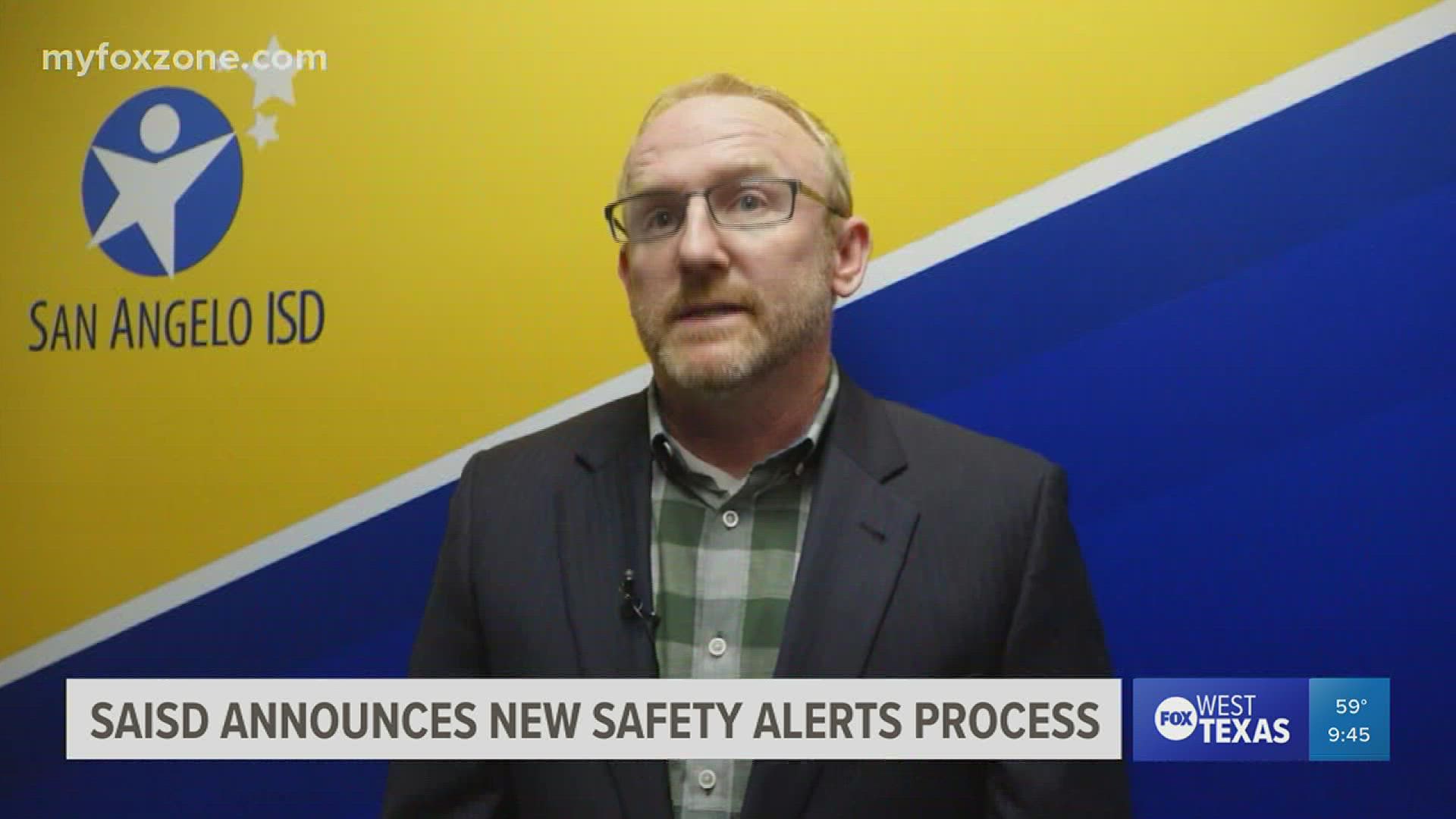SAN ANGELO, Texas — The San Angelo Independent School District announced Tuesday it is launching a new safety alerts process to provide updates on active safety events quickly within the district.
"We took a lot of feedback. We've met with several of our parents and community members to just figure out like what is more meaningful, what is more useful, and then just working with our team here on the best ways and quickest ways that we can get accurate information," SAISD Executive Director of Student and Data Services Michael Kalnbach said
The new alert process involves faster notification of critical safety information through text and email as well as through a dedicated safety alerts webpage, an SAISD release said.
"The original email and text is going to come really quickly because it's just going to be telling what protocol we're in, and then the updates will happen on the website with the link that we're providing. And those updates are going to happen as soon as possible," Kalnbach said.
In an active safety event at an SAISD campus or facility, a notification will be sent out to parents/guardians as quickly as possible. Alerts and updates will also be posted as they become available on the district's website at saisd.org/safety.
"If we can get accurate information to our parents and our students and our staff as quickly as possible, then it helps too. It helps people to be able to filter through all of the misinformation or rumors that are happening," Kalnbach said.
The new webpage is designed to be a single location for communicating safety alerts for campuses. Examples of safety events may include medical emergencies, severe weather events, fire, gas leak, nearby police/criminal activity in the surrounding neighborhood, personal safety issues and threats.
“Our goal is to give parents, students and staff up-to-the-minute, accurate information so our families are in the know during any safety events at our schools,” Kalnbach said in an SAISD release Tuesday.
The district asks parent to understand that depending on the nature of the event, it may not be able to provide exact details or as much information as they would like to know.
The addition of the safety alerts page to already existing safety procedures is part of efforts for more efficiency and timely communications during active safety events.
Kalnbach says the two ways of communicating will be through text message and email. He says close to 98 percent of adults have cellphones, but for those who don't there are resources available.
"For the few people who do not have cell phone access or Internet access, our at-risk coordinators and our school social workers work with families. There's community organizations that will provide that. And so they will connect them to those community organizations that can help them get that kind of access," Kalnbach said.
SAISD uses the Standard Response Protocol (SRP) developed by the Texas State School Safety Center to let parents, teachers, students and staff quickly understand what’s going on, and how to respond during an active safety event. There are five SRP protocol terms based on actions that may be used and shared by SAISD on the safety alerts page during an active safety event.
The five protocol terms are listed below with additional information on each. The district encourages parents and families to familiarize themselves with the terms.
5 SRP Protocol Terms:
- Hold - used when hallways or specific campus areas need to be kept clear. During a Hold, students and staff remain in their classroom or area.
- Secure - implemented when there is a threat or hazard outside of the building. During a Secure, students and staff stay indoors with the exterior doors locked and continue with little classroom interruption.
- Lockdown - used to secure individual rooms and keep students quiet and in place and is initiated when there is a threat inside or very close to the building. During a Lockdown, students and staff remain in a locked classroom, with lights off and out of sight.
- Evacuate - used to move students and staff from one location to a different location in or out of the building. During an evacuation, students and staff move to a location.
- Shelter - called when specific protective actions are needed based on a threat or hazard such as severe weather and a hazardous materials spill. During a shelter, students and staff may evacuate to a shelter area, seal a room, drop, cover and hold, or get to high ground.
"At SAISD, the safety of our students and staff is our top priority, and we are committed to making our schools safer. We will continue to explore and collaborate with local law enforcement and other agencies, Goodfellow representatives, community leaders, and other school districts, and find new ways to improve safety and security. Making our school safer requires continuous work and communication with our students, staff and families," the release said. "SAISD follows recommendations from the Texas School Safety Center, and our safety and security programs address prevention, intervention, student assistance, preparedness, emergency response and building security. The District has an Emergency Operations Plan and all campuses have a Campus Emergency Management Plan that is specific to their campus needs. In August, SAISD administrators delivered a report on School Safety addressing ways SAISD is working to make our schools safer this school year including completion of a Summer Targeted Partial Safety Audit and Exterior Door Safety Audit, collaborative Safety and Security Meetings with local law enforcement, Goodfellow representatives and community leaders, and Behavioral Threat Assessment training for administrators on all campuses. The report includes a status of District Safety Initiatives and resources like Care Solace and StayALERT anonymous reporting."

